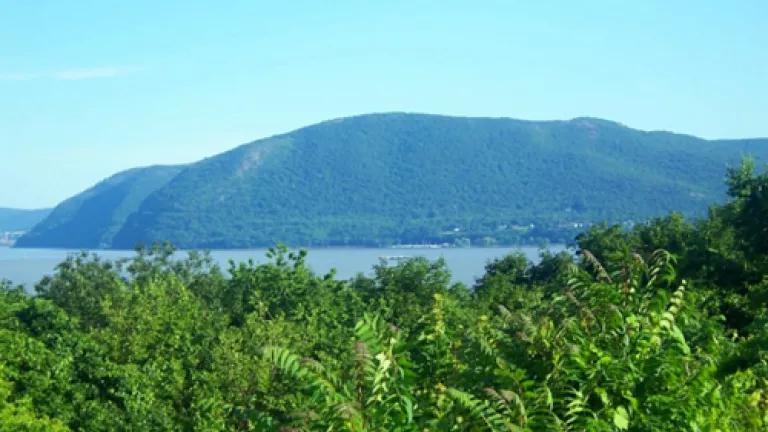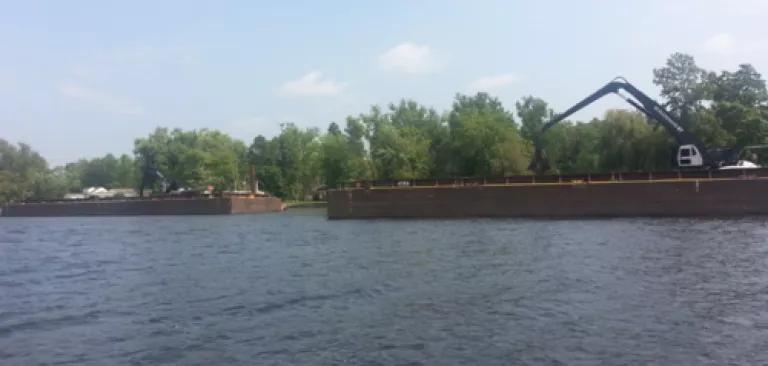
Late last month, I visited one of the largest Superfund sites in the United States—the 197-mile stretch of the Hudson River where General Electric (GE) dumped more than 1.3 million pounds of toxic PCBs, from the mid-1940s through most of the 1970s. After decades of delay and denial of responsibility, GE is finally doing the hard work of removing dangerous PCBs from the river.
The magnificent Hudson River and Storm King Mountain (Daniel Case, CC-BY-SA 3.0).
It doesn’t take an expert to see the damage that these chemicals have caused the Hudson and its communities. The once-thriving commercial fishing industry in the Hudson has been closed for decades, since cancer-causing PCBs, which have also been linked to reproductive, neurological, and developmental disorders, accumulate in the food chain. Fear of spreading PCB pollution has also effectively rendered the Champlain Canal, a valuable commercial shipping artery, inoperative for the last 20 years. Some recreational fishing is allowed, but women of childbearing age and children are advised not to eat any fish from the river at all.
GE’s Hudson River cleanup could potentially restore hope and economic opportunity for millions of people who live and work near the river. Fishing, shipping, tourism and recreation could once again thrive when the river and its surrounding floodplains are restored to health. Unfortunately, GE’s current plans fall short of the mark. The company will only remove 65 percent of the toxic PCBs it dumped in the river. When I went to school, 65 percent was generally considered a D. The Hudson and its communities deserve better.
During my day-long tour of the cleanup effort, which GE and the EPA hosted for NRDC and others from Hudson River Sloop Clearwater, Riverkeeper and Scenic Hudson, I was reminded of the Upper Hudson’s beauty and the tremendous promise that a restored river could hold for the region. I’ve enjoyed swimming, kayaking and fishing in the Hudson, and I’ve seen how the billions of dollars that municipal, state and federal governments have spent to clean up sewage discharges and other pollution have benefitted the river and the public.
It’s time now for GE to do its part.

GE’s dredging operations on the Hudson River (photo by Dan Raichel, NRDC)
The skills and knowledge GE has applied in conducting its cleanup thus far is impressive, but it doesn’t finish the job. GE plans to leave about 80,000 pounds of PCBs, if not more, lingering in the river. And evidence from the dredging so far shows that the contamination may be worse than originally thought. According to the Hudson River Trustees—the group of federal and state agencies responsible for assessing the environmental costs to the public from PCB contamination (legally speaking, they’re assessing GE’s “natural resource damage liability”)—GE’s current dredging plans would leave the “equivalent to a series of Superfund-caliber sites” in the river.
This incomplete cleanup will not allow the river to thrive again.
Leftover PCBs would continue to prevent use of the Champlain Canal. The chemicals would still contaminate fish and other wildlife, and put the health of people using the river at risk. What’s more, leftover PCBs can compromise previously cleaned areas of the river. Pollution in a river doesn’t tend to stay put. Earlier this year, an area around a newly-built kayak launch in Schuylerville, which was thought to be clean, was inundated with PCB-laden mud after a flood.
GE plans to wrap up dredging in 2015 and dismantle its multi-million-dollar cleanup operation shortly thereafter. So the future of the Hudson is at a critical juncture—but that future does not lie in the hands of GE alone. The EPA, although it approved the current “65%-is-good-enough” cleanup plan, still has the authority to order GE to conduct additional dredging.
The Hudson River Trustees can also put pressure on GE by holding GE accountable for the cost of restoring the river—which would no doubt include additional dredging of PCB-contaminated soils—in addition to compensation for costs that the public has already suffered because of damage to the Hudson. The Trustees have been working to assess these natural resource damages for more than a decade. It’s high time the Trustees moved forward and let GE know that it will be responsible for the cost of cleaning up the Hudson, one way or another. It’s also in GE’s interest to cooperate and move quickly, so it can continue using its current cleanup infrastructure and avoid incurring additional natural resource damage liability by further delaying a full cleanup.
Ultimately, the toxic legacy of PCBs in the Hudson is GE’s responsibility. NRDC, along with Hudson River Sloop Clearwater, Riverkeeper, Scenic Hudson, and a coalition of citizens and state and local representatives are calling on GE to do the right thing and complete the dredging of all the additional toxic hotspots in the Hudson and the Champlain Canal.
Sixty-five percent is a start. But it’s not by any means a finish. The people of New York deserve a full, A-level cleanup of the Hudson River—it’s time to give it to them.
